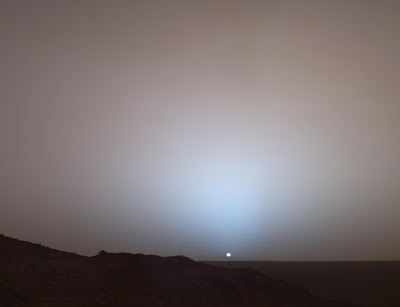Apparently, Mars has blue sunsets all the time. Earth doesn't...
So here's our question: Why are Martian sunsets blue?
On Earth, the air is mostly nitrogen and oxygen. We've also got moisture, dust particles, smoke, aerosols, pollen, salt from the ocean. The atmosphere on Earth is denser — meaning there are more molecules per cubic inch in our air.
Martian air, by contrast, is much, much thinner, about 1 percent the density of air on Earth, plus the gasses are different: they've got CO2, nitrogen and argon, but most important, says Mark Lemmon, associate professor of planetary sciences at Texas A&M University, air on Mars is rich with teeny, teeny particles of dust. Their dust is smaller than our dust, and they've got more of it in the Martian sky. Dust is the key to why the two sunsets look different, so we'll be keeping our eye on Martian dust.
Let's stand facing the sun on Mars. It's early evening. The sun is setting. Light is streaming toward our eyes, moving through the dusty air. What happens?
Sunshine, as you know, contains many different wavelengths of light. If you catch a beam of light in a prism (Newton did this) it breaks into a rainbow of colors — reds, violets, blues. When the sunshine on Mars hits the clouds of fine dust floating through the air, it also breaks into different colors. Martian dust is exactly the right size to absorb the blue wavelengths of light and scatter red wavelengths all over the sky. That's why if you are standing on Mars and look away from the setting sun, most of the sky is rosy, pink, and various shades of red.
But now look straight at the setting sun. On Mars, the beams of light streaming toward you, having lost their red waves, show the wavelengths that haven't scattered off. That remaining light is predominantly blue. So when you look straight at the sun on Mars, you see a haze of blue. Look away from the sun, and the light is red.
One day you wash up on the beach, wet and naked. Another day you wash back out. In between, the scenery changes constantly.
Sunday, June 30, 2013
What Color is the Sunset on Your World?
Subscribe to:
Post Comments (Atom)

No comments:
Post a Comment